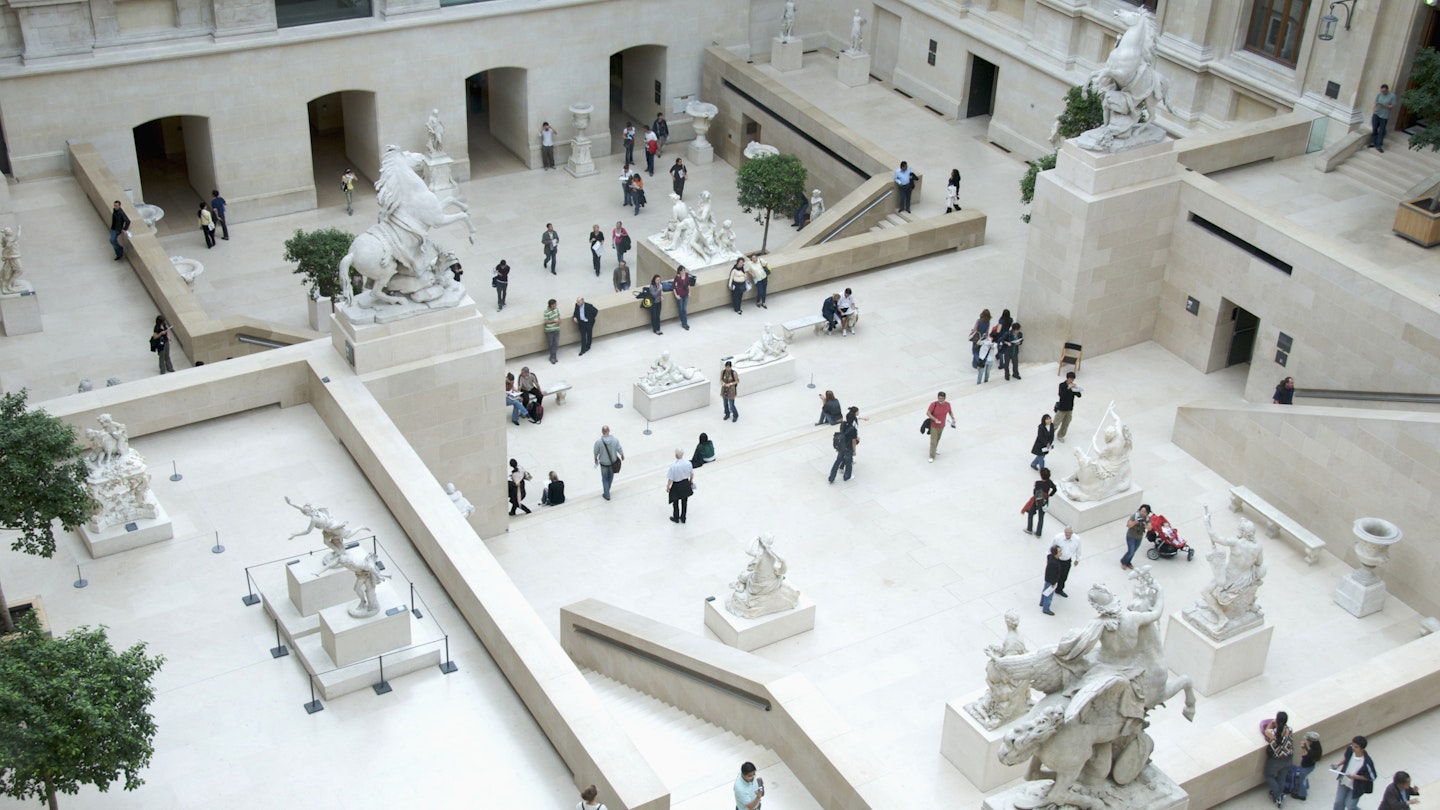Discover the Hidden Gems of the Richelieu Wing at the Louvre
Who doesn’t want to walk in the footsteps of Beyoncé and Jay-Z? The world-famous couple’s stroll through the Musée du Louvre for their 2018 music video Apes**t has brought a record-breaking 10.2 million visitors to the iconic building. However, bypass the crowds and explore the Louvre’s quieter corners in its treasure-packed Richelieu wing instead.
Named after the French clergyman, nobleman, and statesman Cardinal Richelieu (1585–1642), the Richelieu wing is one of the Louvre’s three vast wings (along with the eastern Sully wing and southern Denon wing), running parallel to the rue de Rivoli on the northern side. Away from the museum’s busiest galleries, visitors can unearth magnificent sculptures, Mesopotamian antiquities, Second Empire apartments, decorative arts, and monumental French and northern European canvases.
The Cour Marly
Accessed through the Louvre’s subterranean entrance area Hall Napoléon, the Cour Marly is a spectacular glass-roofed courtyard on the lower ground and ground floors. It’s filled with 17th- and 18th-century French sculptures commissioned by Louis XIV and Louis XV for the Château de Marly, located in Paris, which was destroyed during the Revolution.
Dominating the split-level space are four pedestalled marble horse statues. Antoine Coysevox’s Fame and Mercury account for two of them, depicting two gods astride the winged horse Pegasus, while the second pair are part of Coysevox’s nephew Guillaume I Coustou’s work Horses Restrained by Grooms (also known as Marly Horses), completed in 1745.
French Sculptures
On the western side of Cour Marly’s ground floor, magnificent French sculptures dating from 500 to 1850 AD include several by Germain Pilon (1540–90), considered France’s greatest 16th-century sculptor. Among these is the Fountain of Diana, believed to date from around 1550, portraying Diana, the goddess of hunting, reclining against a stag, accompanied by her two dogs, a greyhound and a water spaniel.

Mesopotamian Antiquities
Reached from the eastern end of Cour Marly, the Louvre’s staggering collection of Near Eastern Antiquities spans from the cradle of civilization. Sumerian, Persian, Anatolian, Punic, Arabian, Palestinian, and other pieces from 5000 BC to 700 AD include board games, furniture, busts, sculptures, masks, bowls, and jewelry. Noteworthy are the archaic writing tablets from 3300 BC and the extraordinary 5m-high stele (stone monument) of the Assyrian Lion and Hero, Winged Bull, circa 700 BC, from the palace of Assyrian King Sargon II.
Napoléon III Apartments
Located on the Richelieu wing’s 1st floor and impressively accessed via the white-stone Lefuel staircase, the jewel-like Napoléon III apartments were built between 1852 and 1857 to accommodate visiting dignitaries. The apartments feature a succession of rooms, incorporating reception areas, a 40-seat dining room, and a music room, all adorned with glittering crystal chandeliers, gleaming gilded furniture, and splendidly frescoed ceilings.

European Decorative Arts
The rest of the wing’s 1st floor, east of the apartments, is dedicated to European decorative arts, particularly from the Middle Ages and Renaissance. Alongside exquisite furniture and tapestries, visitors will see stained glass, silverware, ceramics, ivory and bronze sculptures, jewelry, and notable pieces such as a 15th-century smoked quartz and silver chessboard, 16th-century wine glasses, and a mirror from 1615 decorated with a portrait of 15-year-old Louis XIII on his marriage to Anne of Austria in enamel and metal foil.
Northern European Paintings
Up on the 2nd floor at the western end is the Richelieu wing’s exceptional collection of northern European paintings from 1350 to 1850. Masterpieces include works by Rubens, particularly his Galerie Médicis cycle of 24 paintings, Rembrandt with his Bathsheba at Her Bath (1654), Pieter Bruegel the Elder, Frans Hals, Jan Steen, Van Dyck, and Vermeer, whose The Lacemaker (1669/1670) was regarded by Renoir as the most beautiful painting in the world.
French Paintings
At the eastern end of the Richelieu wing’s 2nd floor, French paintings span from 1350 to 1650. Highlights include Jean Fouquet’s Charles VII (circa 1450), Nicolas Poussin’s biblical scenes such as Eliezer and Rebecca (1648), Georges de La Tour’s The Cheat With the Ace of Diamonds (circa 1637), and Simon Vouet’s Allegory of Wealth (1640).
Petite Galerie
Back on the Richelieu wing’s ground floor, the Petite Galerie is an innovative cultural education space. From October to June every year, it hosts major exhibitions covering various themes, featuring interactive displays, storytelling, readings, films, and other events suitable for all ages.

Top 5 Tips for Exploring the Richelieu Wing
- 1. Exploring this single wing of the museum takes several hours; wear comfortable shoes and bring a bottle of water.
- 2. Tucked between the Napoléon III apartments and European decorative arts galleries on the Richelieu wing’s 1st floor is a branch of Angelina, renowned for serving Paris’ thickest, richest hot chocolate, along with pastries and seasonal dishes.
- 3. Louvre tickets cover the whole museum and are valid all day, allowing flexibility to come and go. Consider purchasing tickets in advance to secure a timed entry.
- 4. Evenings tend to be less crowded; the Louvre remains open until 9:45 PM on Wednesdays, Fridays, and the first Saturday of the month, with free admission from 6 PM to 9:45 PM on the first Saturday of the month.
- 5. Avoid the longest security queues by entering through the underground shopping centre Carrousel du Louvre, directly linked to the Palais Royal–Musée du Louvre metro station.
This article was first published September 13, 2019, and updated May 13, 2021.





